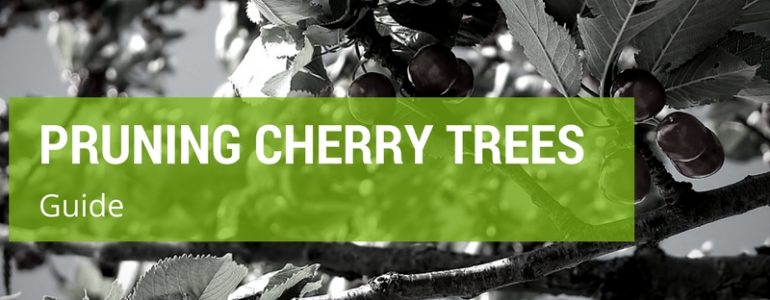The pruning of fruit trees is an important factor in maximizing fruit production and making harvest easy. With cherry trees, you need to know some fairly exacting techniques depending upon the type and age of tree you have. In this article, I will provide an overview of how to prune cherry trees. Read on to learn more.
Why is Cherry Tree Pruning Important?
When you trim your cherry tree correctly, you make it possible for the tree to receive the most benefit from the rays of the sun. This encourages more flower and fruit production and helps the fruit set better.
Additionally, a well pruned tree will resist disease, and you will be better able to reach through the branches to pick the fruit. Good pruning removes weak branches and those growing at odd angles. This lessens the chance of branches breaking under the weight of the fruit.
Best Time to Prune Your Cherry Tree?
For mature sour and weeping cherry trees, perform an aggressive pruning during the late winter when the tree is still dormant. You may also prune these trees after fruit-bearing is complete.
Early spring is the correct time for pruning and shaping young cherry trees of all types. Wait until the buds have emerged and extremely cold weather has passed.
For sweet cherry trees, perform a moderate pruning in the summertime because these types of trees tend to succumb to bacterial and fungal infections, which are more likely to occur with winter pruning. Summertime pruning should be minimal because it depletes the tree’s energy, which is needed for fruit production.
General Cherry Tree Pruning Tools:
- A set of long-handled loppers
- A bypass hand pruner
- A pruning saw
Be sure to sterilise all your tools by wiping the blades with isopropyl alcohol before you start. If you don’t have alcohol (or if you simply prefer it) you can rinse your tool blades with a mixture of 9 parts water to 1 part bleach. Either method will help prevent spread of diseases from other plants in your garden.
How to Prune Cherry Trees When Young
Train your young trees into an open shape that lets in plenty of light and air. This will help the tree produce more blooms and fruit.
In springtime, trim off all suckers right down to the branch collar. This is a raised area that marks the meeting of the stem and the trunk. Doing this will help your tree use its energy productively. You should also remove broken, diseased and dead branches in the springtime.
In the autumn, you can “head” the tree. Cut back branches (at a 45 degree angle) by as much as one-half the overall length of the branch. Doing this helps shape the tree and encourages the lateral growth of branches. Only perform this maintenance on saplings that are over 30” high and only during the first two or three years.
After the second or third year, progress to make a “scaffold whorl”. This is a set of four lateral branches that extend from the central trunk of the tree like the spokes of a wheel. The best branches to retain for this structure are those that are sturdy, evenly spaced and grow at a 45-60 degree angle.
They should be separated by eight inches or more vertically, and the lowest branch should be a minimum of eighteen inches from the base of the tree trunk. These four branches should be trimmed back to a length of two feet each. Use quarter-inch angle cuts above the flower buds. Remove all extraneous branches with clean cuts against the main trunk.
In the third or fourth year, when the tree is taller, repeat this process to create a second scaffold whorl just above the first one.
How to Prune Cherry Trees When Mature
When your tree has reached its fourth or fifth year and you have completed shaping and training it, you are ready to promote its outward growth. You would do this by removing new vertical limbs with your pruning saw or your loppers. Remove limbs that have grown in a tangle or crisscrossed.
Remember to use sterilised pruning implements. Prune healthy limbs before removing dead, damaged and diseased growth. Use tree sealant to cover all the cuts and ward of fungus and viruses. Dispose of trimmed off limbs properly to prevent the spread of disease (buy a garden incinerator).
How Do You Know You Are Successful?
If your tree is healthy and producing well, you are successful. Strive to train your tree to good looks, balance and manageability. As when working with any living thing, be flexible. Study your tree and imagine how you want it to look. Trim away the bits that don’t fulfill your vision while taking care not to damage or stress the tree.


![Best Secateurs [Buying Guide + Reviews] Best Secateurs [Buying Guide + Reviews]](https://www.gardendad.co.uk/wp-content/uploads/2018/01/best-secateurs-reviews-70x70.jpg)





Hi Jack. We have a young cherry tree on our allotments which is certainly more than five years old. It has a good sized bole now. I need to take out the lead branch or two and shorten others as it is going heavenwards and will soon be taking light from people’s plots. It was abandoned by the people who planted it and we suddenly noticed it was becoming a problem. It maybe as much as 10 years old. I have read your advice on pruning mature trees but you don’t state when to do this. Am I correct in assuming late spring, early summer? Or should it be left to autumn? Thank you so much. Marcia – site rep
I have a seedling… it’s only 4 inches tall
And super skinny trunk is that normal?